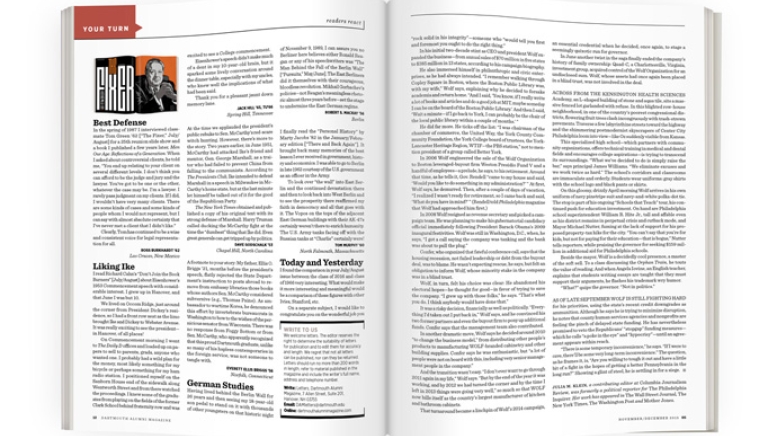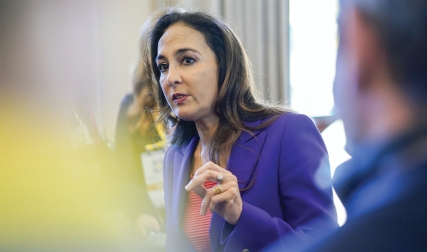Best Defense
In the spring of 1987 I interviewed classmate Tom Green ’62 [“The Fixer,” July/August] for a 25th reunion slide show and a book I published a few years later, Men Our Age: Reflections of a Generation. When I asked about controversial clients, he told me, “You end up relating to your client on several different levels. I don’t think you can afford to be the judge and jury and the lawyer. You’ve got to be one or the other, whatever the case may be. I’m a lawyer. I rarely pass judgment on my clients. If I did, I wouldn’t have very many clients. There are some kinds of cases and some kinds of people whom I would not represent, but I can say with almost absolute certainty that I’ve never met a client that I didn’t like.”
Clearly, Tom has continued to be a wise and consistent voice for legal representation for all.
Ross Burkhardt ’62
Las Cruces, New Mexico
Liking Ike
I read Richard Cahn’s “Don’t Join the Book Burners” [July/August] about Eisenhower’s 1953 Commencement speech with considerable interest. I grew up in Hanover, and that June I was but 10.
We lived on Occom Ridge, just around the corner from President Dickey’s residence, so I had a front row seat as the limo brought Ike and Dickey to Webster Avenue. It was really exciting to see the president—in Hanover, of all places!
On Commencement morning I went to The Daily D offices and loaded up on papers to sell to parents, grads, anyone who wanted one. I probably had a wild plan for the money, most likely something for my bicycle or perhaps something for my ham radio station. I positioned myself on the Sanborn House end of the sidewalk along Wentworth Street and from there watched the proceedings. I knew some of the graduates from playing on the fields of the former Clark School behind fraternity row and was excited to see a College commencement.
Eisenhower’s speech didn’t make much of a dent in my 10-year-old brain, but it sparked some lively conversation around the dinner table, especially with my uncles, who knew well the implications of what had been said.
Thank you for a pleasant jaunt down memory lane.
Jack Hill ’65, Tu’66
Spring Hill, Tennessee
At the time we applauded the president’s public rebuke to Sen. McCarthy’s red-scare witch hunting. However, there’s more to the story. Two years earlier, in June 1951, McCarthy had attacked Ike’s friend and mentor, Gen. George Marshall, as a traitor who had failed to prevent China from falling to the communists. According to The Presidents Club, Ike intended to defend Marshall in a speech in Milwaukee in McCarthy’s home state, but at the last minute let himself be talked out of it for the good of the Republican Party.
The New York Times obtained and published a copy of his original text with its strong defense of Marshall. Harry Truman called ducking the McCarthy fight at the time the “dumbest” thing that Ike did. Even great generals can get tripped up by politics.
Dave Godschalk ’53
Chapel Hill, North Carolina
A footnote to your story: My father, Ellis O. Briggs ’21, months before the president’s speech, flatly rejected the State Department’s instruction to posts abroad to remove from embassy libraries those books whose authors Sen. McCarthy considered subversive (e.g., Thomas Paine). As ambassador to wartime Korea, he denounced this effort by invertebrate bureaucrats in Washington to bow to the wishes of the pernicious senator from Wisconsin. There was no response from Foggy Bottom or from Sen. McCarthy, who apparently recognized that this proud Dartmouth graduate, unlike so many of his hapless contemporaries in the foreign service, was not someone to tangle with.
Everett Ellis Briggs ’56
Norfolk, Connecticut
German Studies
Having lived behind the Berlin Wall for 26 years and then seeing my 18-year-old son pedal to stand on it with thousands of other youngsters on that historic night of November 9, 1989, I can assure you no Berliner here believes either Ronald Reagan or any of his speechwriters was “The Man Behind the Fall of the Berlin Wall” [“Pursuits,” May/June]. The East Berliners did it themselves with their courageous, bloodless revolution. Mikhail Gorbachev’s policies—not Reagan’s meaningless rhetoric almost three years before—set the stage to undermine the East German regime.
Robert S. Mackay ’56
Berlin
I finally read the “Personal History” by Marty Jacobs ’82 in the January/February edition [“There and Back Again”]. It brought back many memories of the best lesson I ever received in government, history and economics. I was able to go to Berlin in late 1962 courtesy of the U.S. government as an officer in the Army.
To look over “the wall” into East Berlin and the continued devastation there and then to look back into West Berlin and to see the prosperity there reaffirmed my faith in democracy and all that goes with it. The Vopos on the tops of the adjacent East German buildings with their AK-47s certainly weren’t there to enrich humanity. The U.S. Army tanks facing off with the Russian tanks at “Charlie” certainly were!
Tom Murphy ’60
North Falmouth, Massachusetts
Today and Yesterday
I found the comparison in your July/August issue between the class of 2016 and class of 1966 very interesting. What would make it more interesting and meaningful would be a comparison of these figures with other Ivies, Stanford, etc.
On a separate subject, I would like to congratulate you on the wonderful job you are doing with DAM. I have special feelings about the magazine since I was president of the Alumni Council and led the fight to keep it independent when President McLaughlin and the trustees tried to take it over. Your efforts today confirm our fight to maintain its independence.
Joel Portugal ’58
New York City
A Matter of Degrees
Thanks for the recent translation of the Dartmouth diploma [“Diplomacy,” July/August]. I could have used this 12 years ago. I had begun work for a project in northern Thailand, and naturally in the course of my employer sorting a work permit, they needed credentials. When the HR professional asked me what it said, she was understandably shocked that I didn’t know. Rather than try and explain the place of Latin in Western civilization (moreover, in Thai, a language I had little command of at the time), I think I provided a highly suspect translation. It worked, but I am nevertheless keeping this translation for the future.
Caroline Pott ’02
St. Croix, U.S. Virgin Islands
Your “Diplomacy” page brought back the many hours I spent lettering diplomas upstairs in the administration building as a student employee of the College. I would go over there a few afternoons a week and sit at a drafting board with a Leroy lettering set, which are still available on the web for $125.
The diplomas were all preprinted. When I got them, all that was needed was the graduate’s name and the signatures. I lined up the diploma edge to the T-square on the drafting table. The appropriate Leroy lettering font was located higher on the board. The Leroy ink pen consisted of a 2-diameter machined tube with the larger one on top holding the India ink and the lower one just large enough to create the width of the letter being drawn. Each letter was drawn individually, and I had to take care to assure the spaces between letters were the same. I can’t remember what I got paid, but it must’ve been 25 to 50 cents per diploma, and I probably did six to 10 per hour. If these were the numbers, it was good pay for those days.
Gayne Kalustian ’17 did a great job. Keep up the good work.
Merle Thorpe ’51, Th’53
Hanover
PC Police
In your most recent issue you report President Phil Hanlon ’77 declared sign-defacing activism “an unacceptable violation of freedom of expression” [“Campus,” July/August]. Last issue you reported that a fraternity was sanctioned for having a piece of Indian head decor. Would it kill you guys to do some actual journalism here and nail these hypocritical inconsistencies? Would that stand in the way of your primary mission: political correctness?
Peter Humphrey ’76
Rockville, Maryland
Different Strokes
I admire Fay Wells, Tu’06 [“In the Crossfire,” May/June], for her calm composure when assaulted by intruders, the first being an offensive neighbor calling the police, then by an overload of force. My heart goes out to her for suffering needless loss of peacefulness.
Roger E. Condit ’59
Farmington, Maine
I knew from the moment I opened my mailbox and saw the front cover of the May/June DAM that I was in for some rough reading: More grievance, victimhood and political correctness. Yes, it was an interesting read. I particularly enjoyed the article about the sculptures of fellow alumnus David Stromeyer ’68. What a wonderful mixture of intellectualism, materials and rural New England landscapes. What could be more evocative of Dartmouth?
As for the rest of the issue (aside from the “Class Notes”), it was full of the same sort of oppressive, social-justice-journalism that caused me to stop reading The New York Times, the Los Angeles Times and The Wall Street Journal. If I want stick-it-to-the-man grievance mongering, I can read any newspaper or watch the news on TV.
Weeks after reading the story I was taking a regular bike ride through Santa Monica, California, and observed no fewer than seven Santa Monica Police Department squad cars responding to curb-side incident involving two white suspects who appeared to be compliant: a young man, and a young woman. Approximately five Santa Monica police officers stood over them. Six squad cars, with lights flashing, were parked in single file at the scene. A seventh squad car approached from around the block. I would estimate that at least 10, and likely more, Santa Monica police officers were at the scene. The police response that I observed happens all the time in Santa Monica.
Please read this factual account as a cautionary tale before you publish future context-lacking “social justice” stories.
William L. “Bill” Robbins ’83
Los Angeles
President Hanlon’s May 3 letter to the Dartmouth community and the spring 2016 issue of Dartmouth Life only reinforce the reality given in the May/June issue of DAM. Your story about first-generation students [“First”] demonstrates that diversity in and of itself, rather than the pursuit of knowledge and excellence, has become the driving focus in Dartmouth’s raison d’être.
Diversity of what? Racial, ethnic, religious background? What percentage of Asians shall we admit, or should we further subdivide by Chinese, Japanese, Koreans and Indians? What about Christians? Or further subdivide by a certain percentage of Presbyterians, Methodists, Baptists and Evangelicals? People of color? What color? Is white a color or a state of mind? And are there sufficient safe places on campus where one can retreat to avoid uncomfortable words or thoughts?
An important function of higher education once was thought to be the expansion of one’s knowledge and growth in the ability to reason. Now it seems to be more focused on “Kumbaya” feelings and political correctness. No deviant thoughts here! What’s next? Nap time with milk and cookies in the afternoon?
E. Robert Quasman ’65
Woodstock, Vermont




